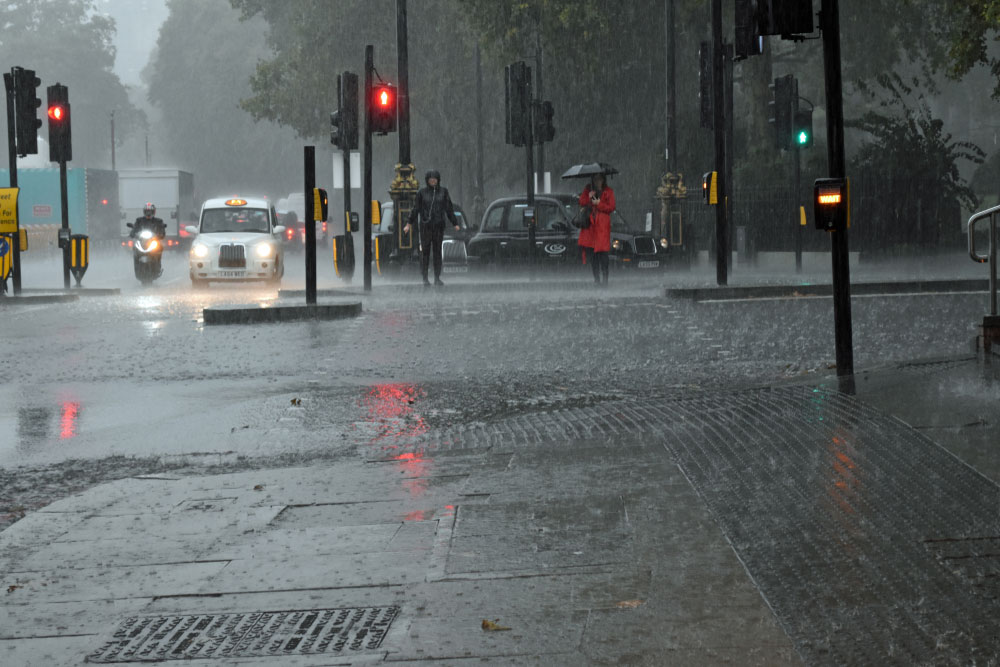The recent flash floods we have seen in London and across Europe have been utterly devastating.
For those people directly affected by flash floods, the aftermath can be life changing.
In this article we will explore what flash floods are, why they are so dangerous, why they are happening more frequently and how we are likely to see more of this if changes aren’t made quickly. We will also provide you with some recommendations to put in place to protect yourself from flooding and to mitigate damage.
What are flash floods?
Flash floods, as the name would suggest, happen very quickly with very little warning. They are caused by intense rainfall which falls so quickly it becomes too much for our drains and sewers to cope.
Flash floods can be worse following extremely hot weather, as this causes the ground to dry out and become incredibly hard and therefore isn’t able to soak up the fast falling rain water. This makes flash flooding more common in areas like cities, where there are a lot of hard surfaces, such as roads, pavements and paved gardens.
During flash floods, drains can quickly overflow, taking the water above the curb and into buildings. Roads can quickly turn into rivers, with enough strength to carry many objects in its path along with it.
Why are flash floods so dangerous?
The most devastating impact of flash floods is loss of life. Just 6 inches of fast flowing flood water can sweep someone off their feet, making navigating through flood water treacherous. It is strongly recommended not to attempt to drive a vehicle through flood water as just 12 inches of fast flowing flood water is enough to move a car. Sadly vehicle related deaths are the most common during flash floods.
All floodwater is considered contaminated, as it may contain sewage, animal waste, pollutants and harmful bacteria. This water can be incredibly harmful to people, animals and the environment. Care must be taken when faced with flood water and protective closing should be worn.
Flood water can cause damage to building materials and furniture and fittings. It can cause wood to rot and mould to grow, it therefore needs to be dealt with quickly to mitigate that damage.
Flash floods can have a huge impact on vegetation, farmers have reported losses of up to 90% of crops following the recent heavy rainfall and floods. Loss of livestock is another tragic impact of the floods as with very little warning, it can be difficult to get livestock to safety in time.
How was London recently affected?
We have seen on the news in July 2021 how bad the flash floods have been in London. On the 25th July London experienced a month's rainfall in a matter of hours. Homes and businesses were flooded and roads quickly turned into rivers.
Residents had to be evacuated from their homes. Roads and tube stations were flooded, cars and broken down buses were left stranded meaning trains and other transport had to be cancelled.

Two London hospitals were impacted by flooding and loss of power. The London Fire Brigade reported hundreds of calls following the rainfall.
Europe has also been affected recently, again in July 2021 we witnessed extreme flooding in western Europe with Germany, Belgium and the Netherlands being hardest hit.
Why are flash floods becoming more frequent?
Climate change is the biggest factor in the increase of flash floods. The increase in the temperature of the earth's atmosphere, caused by increased co2 emissions and other pollutants is increasing the frequency of extreme weather events, such as heatwaves and storms.
A recent article written in The Guardian, reports scientists warnings that flash floods will be more common as the climate crisis worsens.
What changes need to be made to better protect us from flash floods?
Over the years the accuracy of weather forecasting has improved, providing better predictions of flash floods allowing for better flood warnings, giving people time to prepare. We do however, require further investment in surface water flood mapping to ensure we continually update those areas at risk.
The UK government, as do governments all over the world, needs to make huge changes to better protect us from flash floods.
There are currently a number of initiatives in place to reduce our emissions to help deal with climate change. These will take time to implement and in the meantime we are clearly seeing the impact of climate change so our infrastructure needs to change. Our drainage systems and water supply systems need to be improved. Permeable paving would be a better option for roads and pavements as it is porous and allows water to pass through it. More tidal barriers also need to be installed and maintained.
Local councils will require additional funding to be able to put measures required in their areas to better deal with floods.
Green roofs are a hugely beneficial option which over time could make a difference. A green roof is a roof covered in grass and plants, over a waterproofing system. The UK has been slow to move with this, however it is popular in countries in Europe, especially in Germany.

Green roofs have a number of benefits for the environment and can be used as a habitat for insects and wildlife. It can provide better insulation for homes and businesses, thereby reducing fuel costs. It helps to improve air quality and reduce the temperature of the environment. It can also help control water in heavy rainfall.
7 tips to help you to prepare for flooding
In every home and business there is a risk of flooding from an internal or external ingress of water. There are a number of actions you can take to prevent flooding in your home or mitigate the damage.
Create a flood plan - this is especially important for homes at risk of flooding. A flood plan will give you the opportunity to identify the best way to respond to a flood before it even happens. There are some helpful documents on the government website which will help with this - https://www.gov.uk/government/publications/personal-flood-plan
Check your roof - check the roof of your building for leaks or damaged tiles, also remove moss or any other debris that could find its way into your gutters and potentially block them.
Check your gutters and drains - gutters can easily become blocked or broken as can drains and underground pipes. Any issues should be resolved as quickly as possible.
Deal with sewage issues quickly - tackle any problems with sewage quickly as this can lead to a sewage back up into your property, our article ‘Common Causes of Home Sewage Back Ups’ identifies signs that show that there could be a problem in your property.
Waterproof your basement - flooded basements are a common problem. You can arrange to have your basement waterproofed (also referred to as tanking) and have a sump pump fitted to automatically pump water out of the basement. It is also important to ensure you do not leave valuables in the basement. You may also want to think about the type of flooring you put down, tiled flooring would be much easier to deal with following a flood than carpet would.
Check your home insurance - check what cover you have, especially if you live in an area that is identified as ‘at risk’ of flooding.
Research professional water damage restoration companies - have the details of a professional company like Flood Dr to hand. The Flood Dr are experts in water damage remediation and restoration, available 24/7 to deal with your emergency. 0208 528 3311







